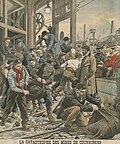Mining accident
Mining accident refers to an accident that occurs during the process of mining minerals or metals. Thousands of miners die from mining accidents each year, especially in the processes of coal mining and hard rock mining. Most of the world's deadliest mining accidents occur in coal mines in developing countries. The primary causes of mining accidents are explosions, cave-ins, and equipment accidents. These incidents can also result in a significant number of injuries and long-term health problems, such as black lung disease.
Causes
The main causes of mining accidents can be attributed to:
- Explosions and fires: In coal mines, methane gas can build up in underground tunnels, which can be ignited by a spark from mining equipment, leading to an explosion. Coal dust can also be highly explosive.
- Cave-ins and rock falls: The structural failure of mines can lead to cave-ins, where miners can be trapped or buried under debris.
- Equipment accidents: The use of heavy machinery in confined spaces can lead to accidents, including collisions, equipment malfunction, and failure to use proper safety equipment.
- Flooding: Water inrushes can flood tunnels, trapping miners underground.
- Toxic gas releases: The release of toxic gases such as methane, carbon monoxide, and hydrogen sulfide can pose significant risks to miners.
Prevention
Preventive measures to reduce the incidence of mining accidents include:
- Proper ventilation: To prevent the accumulation of flammable gases.
- Regular safety drills: To ensure that all workers know how to respond in case of an emergency.
- Use of modern equipment and safety gear: To protect miners from the hazards of mining operations.
- Strict enforcement of safety regulations: Governments and mining companies must enforce safety standards to protect workers.
- Continuous monitoring of air quality and structural integrity: To detect and address potential hazards before they lead to accidents.
Notable Mining Accidents
Some of the most notable mining accidents include:
- The Courrières mine disaster in 1906 in France, which is the deadliest mining disaster in Europe.
- The Benxihu Colliery disaster in 1942 in China, the world's deadliest coal mining disaster.
- The Sago Mine disaster in 2006 in the United States, which led to significant media coverage and policy changes regarding mine safety.
Conclusion
Mining accidents are a significant concern in the mining industry, affecting thousands of workers each year. While the industry has made strides in improving safety measures, the inherent dangers of mining operations continue to pose risks. Ongoing efforts to enhance safety protocols, technology, and training are essential to reducing the frequency and severity of mining accidents.
This safety related article is a stub. You can help WikiMD by expanding it.
Transform your life with W8MD's budget GLP-1 injections from $125.
W8MD offers a medical weight loss program to lose weight in Philadelphia. Our physician-supervised medical weight loss provides:
- Most insurances accepted or discounted self-pay rates. We will obtain insurance prior authorizations if needed.
- Generic GLP1 weight loss injections from $125 for the starting dose.
- Also offer prescription weight loss medications including Phentermine, Qsymia, Diethylpropion, Contrave etc.
NYC weight loss doctor appointments
Start your NYC weight loss journey today at our NYC medical weight loss and Philadelphia medical weight loss clinics.
- Call 718-946-5500 to lose weight in NYC or for medical weight loss in Philadelphia 215-676-2334.
- Tags:NYC medical weight loss, Philadelphia lose weight Zepbound NYC, Budget GLP1 weight loss injections, Wegovy Philadelphia, Wegovy NYC, Philadelphia medical weight loss, Brookly weight loss and Wegovy NYC
|
WikiMD's Wellness Encyclopedia |
| Let Food Be Thy Medicine Medicine Thy Food - Hippocrates |
Medical Disclaimer: WikiMD is not a substitute for professional medical advice. The information on WikiMD is provided as an information resource only, may be incorrect, outdated or misleading, and is not to be used or relied on for any diagnostic or treatment purposes. Please consult your health care provider before making any healthcare decisions or for guidance about a specific medical condition. WikiMD expressly disclaims responsibility, and shall have no liability, for any damages, loss, injury, or liability whatsoever suffered as a result of your reliance on the information contained in this site. By visiting this site you agree to the foregoing terms and conditions, which may from time to time be changed or supplemented by WikiMD. If you do not agree to the foregoing terms and conditions, you should not enter or use this site. See full disclaimer.
Credits:Most images are courtesy of Wikimedia commons, and templates, categories Wikipedia, licensed under CC BY SA or similar.
Contributors: Prab R. Tumpati, MD








